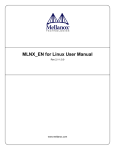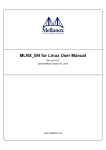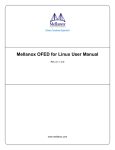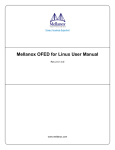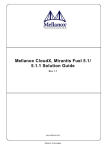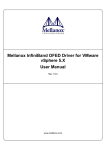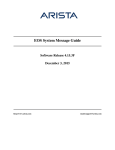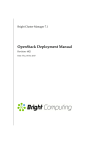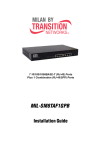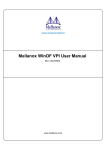Download MLNX_EN for Linux User Manual
Transcript
MLNX_EN for Linux
User Manual
Rev 2.2-1.0.1
www.mellanox.com
Rev 2.2-1.0.1
NOTE:
THIS HARDWARE, SOFTWARE OR TEST SUITE PRODUCT (“PRODUCT(S)”) AND ITS RELATED
DOCUMENTATION ARE PROVIDED BY MELLANOX TECHNOLOGIES “AS-IS” WITH ALL FAULTS OF ANY
KIND AND SOLELY FOR THE PURPOSE OF AIDING THE CUSTOMER IN TESTING APPLICATIONS THAT USE
THE PRODUCTS IN DESIGNATED SOLUTIONS. THE CUSTOMER'S MANUFACTURING TEST ENVIRONMENT
HAS NOT MET THE STANDARDS SET BY MELLANOX TECHNOLOGIES TO FULLY QUALIFY THE
PRODUCTO(S) AND/OR THE SYSTEM USING IT. THEREFORE, MELLANOX TECHNOLOGIES CANNOT AND
DOES NOT GUARANTEE OR WARRANT THAT THE PRODUCTS WILL OPERATE WITH THE HIGHEST
QUALITY. ANY EXPRESS OR IMPLIED WARRANTIES, INCLUDING, BUT NOT LIMITED TO, THE IMPLIED
WARRANTIES OF MERCHANTABILITY, FITNESS FOR A PARTICULAR PURPOSE AND NONINFRINGEMENT
ARE DISCLAIMED. IN NO EVENT SHALL MELLANOX BE LIABLE TO CUSTOMER OR ANY THIRD PARTIES
FOR ANY DIRECT, INDIRECT, SPECIAL, EXEMPLARY, OR CONSEQUENTIAL DAMAGES OF ANY KIND
(INCLUDING, BUT NOT LIMITED TO, PAYMENT FOR PROCUREMENT OF SUBSTITUTE GOODS OR SERVICES;
LOSS OF USE, DATA, OR PROFITS; OR BUSINESS INTERRUPTION) HOWEVER CAUSED AND ON ANY
THEORY OF LIABILITY, WHETHER IN CONTRACT, STRICT LIABILITY, OR TORT (INCLUDING NEGLIGENCE
OR OTHERWISE) ARISING IN ANY WAY FROM THE USE OF THE PRODUCT(S) AND RELATED
DOCUMENTATION EVEN IF ADVISED OF THE POSSIBILITY OF SUCH DAMAGE.
Mellanox Technologies
350 Oakmead Parkway Suite 100
Sunnyvale, CA 94085
U.S.A.
www.mellanox.com
Tel: (408) 970-3400
Fax: (408) 970-3403
Mellanox Technologies, Ltd.
Beit Mellanox
PO Box 586 Yokneam 20692
Israel
www.mellanox.com
Tel: +972 (0)74 723 7200
Fax: +972 (0)4 959 3245
© Copyright 2014. Mellanox Technologies. All Rights Reserved.
Mellanox®, Mellanox logo, BridgeX®, ConnectX®, Connect-IB®, CORE-Direct®, InfiniBridge®, InfiniHost®,
InfiniScale®, MetroX®, MLNX-OS®, PhyX®, ScalableHPC®, SwitchX®, UFM®, Virtual Protocol Interconnect® and
Voltaire® are registered trademarks of Mellanox Technologies, Ltd.
ExtendX™, FabricIT™, Mellanox Open Ethernet™, Mellanox Virtual Modular Switch™, MetroDX™, TestX™,
Unbreakable-Link™ are trademarks of Mellanox Technologies, Ltd.
All other trademarks are property of their respective owners.
2
Mellanox Technologies
Document Number: 2950
Rev 2.2-1.0.1
Table of Contents
Table of Contents . . . . . . . . . . . . . . . . . . . . . . . . . . . . . . . . . . . . . . . . . . . . . . . . . . . . . . . . . . 3
List of Tables . . . . . . . . . . . . . . . . . . . . . . . . . . . . . . . . . . . . . . . . . . . . . . . . . . . . . . . . . . . . . 5
Chapter 1 Overview . . . . . . . . . . . . . . . . . . . . . . . . . . . . . . . . . . . . . . . . . . . . . . . . . . . . . . 10
1.1
Package Contents. . . . . . . . . . . . . . . . . . . . . . . . . . . . . . . . . . . . . . . . . . . . . . . . . 10
Chapter 2 Driver Installation . . . . . . . . . . . . . . . . . . . . . . . . . . . . . . . . . . . . . . . . . . . . . . 12
2.1
2.2
2.3
2.4
2.5
Software Dependencies . . . . . . . . . . . . . . . . . . . . . . . . . . . . . . . . . . . . . . . . . . . .
Installing the Driver . . . . . . . . . . . . . . . . . . . . . . . . . . . . . . . . . . . . . . . . . . . . . . .
Loading the Driver. . . . . . . . . . . . . . . . . . . . . . . . . . . . . . . . . . . . . . . . . . . . . . . .
Unloading the Driver . . . . . . . . . . . . . . . . . . . . . . . . . . . . . . . . . . . . . . . . . . . . . .
Uninstalling the Driver . . . . . . . . . . . . . . . . . . . . . . . . . . . . . . . . . . . . . . . . . . . .
12
12
13
13
13
Chapter 3 Ethernet Driver Usage and Configuration . . . . . . . . . . . . . . . . . . . . . . . . . . 14
Chapter 4 Firmware Programming . . . . . . . . . . . . . . . . . . . . . . . . . . . . . . . . . . . . . . . . . 16
4.1
4.2
Installing Firmware Tools . . . . . . . . . . . . . . . . . . . . . . . . . . . . . . . . . . . . . . . . . . 16
Updating Adapter Card Firmware . . . . . . . . . . . . . . . . . . . . . . . . . . . . . . . . . . . . 16
Chapter 5 Driver Features . . . . . . . . . . . . . . . . . . . . . . . . . . . . . . . . . . . . . . . . . . . . . . . . 17
5.1
Quality of Service . . . . . . . . . . . . . . . . . . . . . . . . . . . . . . . . . . . . . . . . . . . . . . . . 17
5.1.1
5.1.2
5.1.3
5.1.4
5.1.5
5.2
Mapping Traffic to Traffic Classes . . . . . . . . . . . . . . . . . . . . . . . . . . . . . . . . . . . .
Plain Ethernet Quality of Service Mapping . . . . . . . . . . . . . . . . . . . . . . . . . . . . .
Map Priorities with tc_wrap.py/mlnx_qos . . . . . . . . . . . . . . . . . . . . . . . . . . . . . .
Quality of Service Properties . . . . . . . . . . . . . . . . . . . . . . . . . . . . . . . . . . . . . . . .
Quality of Service Tools . . . . . . . . . . . . . . . . . . . . . . . . . . . . . . . . . . . . . . . . . . . .
17
17
18
18
19
Time-Stamping Service . . . . . . . . . . . . . . . . . . . . . . . . . . . . . . . . . . . . . . . . . . . . 23
5.2.1 Enabling Time Stamping. . . . . . . . . . . . . . . . . . . . . . . . . . . . . . . . . . . . . . . . . . . . 24
5.2.2 Getting Time Stamping . . . . . . . . . . . . . . . . . . . . . . . . . . . . . . . . . . . . . . . . . . . . . 25
5.3
Flow Steering. . . . . . . . . . . . . . . . . . . . . . . . . . . . . . . . . . . . . . . . . . . . . . . . . . . . 26
5.3.1 Enable/Disable Flow Steering. . . . . . . . . . . . . . . . . . . . . . . . . . . . . . . . . . . . . . . . 26
5.3.2 Flow Domains and Priorities. . . . . . . . . . . . . . . . . . . . . . . . . . . . . . . . . . . . . . . . . 26
5.4
Single Root IO Virtualization (SR-IOV) . . . . . . . . . . . . . . . . . . . . . . . . . . . . . . . 28
5.4.1
5.4.2
5.4.3
5.4.4
5.4.5
5.4.6
5.5
5.6
System Requirements . . . . . . . . . . . . . . . . . . . . . . . . . . . . . . . . . . . . . . . . . . . . . .
Setting Up SR-IOV . . . . . . . . . . . . . . . . . . . . . . . . . . . . . . . . . . . . . . . . . . . . . . . .
Enabling SR-IOV and Para Virtualization on the Same Setup . . . . . . . . . . . . . . .
Assigning a Virtual Function to a Virtual Machine . . . . . . . . . . . . . . . . . . . . . . .
Uninstalling SR-IOV Driver . . . . . . . . . . . . . . . . . . . . . . . . . . . . . . . . . . . . . . . . .
Ethernet Virtual Function Configuration when Running SR-IOV . . . . . . . . . . . .
28
29
35
37
38
38
Ethtool . . . . . . . . . . . . . . . . . . . . . . . . . . . . . . . . . . . . . . . . . . . . . . . . . . . . . . . . . 39
Ethernet VXLAN. . . . . . . . . . . . . . . . . . . . . . . . . . . . . . . . . . . . . . . . . . . . . . . . . 41
5.6.1 Prerequisites . . . . . . . . . . . . . . . . . . . . . . . . . . . . . . . . . . . . . . . . . . . . . . . . . . . . . 41
5.6.2 Enabling VXLAN . . . . . . . . . . . . . . . . . . . . . . . . . . . . . . . . . . . . . . . . . . . . . . . . . 42
5.6.3 Important Notes. . . . . . . . . . . . . . . . . . . . . . . . . . . . . . . . . . . . . . . . . . . . . . . . . . . 42
5.7
Quantized Congestion Control . . . . . . . . . . . . . . . . . . . . . . . . . . . . . . . . . . . . . . 42
5.7.1 QCN Tool - mlnx_qcn . . . . . . . . . . . . . . . . . . . . . . . . . . . . . . . . . . . . . . . . . . . . . 43
Mellanox Technologies
3
Rev 2.2-1.0.1
5.7.2 Setting QCN Configuration. . . . . . . . . . . . . . . . . . . . . . . . . . . . . . . . . . . . . . . . . . 45
5.8 pm_qos usage on ingress Packet Traffic . . . . . . . . . . . . . . . . . . . . . . . . . . . . . . . 45
5.9 XOR RSS Hash Function . . . . . . . . . . . . . . . . . . . . . . . . . . . . . . . . . . . . . . . . . . 45
5.10 Ethernet Performance Counters . . . . . . . . . . . . . . . . . . . . . . . . . . . . . . . . . . . . . . 46
Chapter 6 Performance . . . . . . . . . . . . . . . . . . . . . . . . . . . . . . . . . . . . . . . . . . . . . . . . . . . 51
4
Mellanox Technologies
Rev 2.2-1.0.1
List of Tables
Table 1:
Table 2:
Table 3:
Table 4:
Table 5:
Table 6:
Table 7:
Table 8:
Table 9:
Table 10:
Table 11:
Table 12:
Table 13:
Table 14:
Document Revision History . . . . . . . . . . . . . . . . . . . . . . . . . . . . . . . . . . . . . . . . . . . . . . . . 6
Abbreviations and Acronyms . . . . . . . . . . . . . . . . . . . . . . . . . . . . . . . . . . . . . . . . . . . . . . . 7
Glossary . . . . . . . . . . . . . . . . . . . . . . . . . . . . . . . . . . . . . . . . . . . . . . . . . . . . . . . . . . . . . . . . 8
Reference Documents . . . . . . . . . . . . . . . . . . . . . . . . . . . . . . . . . . . . . . . . . . . . . . . . . . . . . 9
MLNX_EN Package Content . . . . . . . . . . . . . . . . . . . . . . . . . . . . . . . . . . . . . . . . . . . . . . 10
Flow Specific Parameters . . . . . . . . . . . . . . . . . . . . . . . . . . . . . . . . . . . . . . . . . . . . . . . . . 27
ethtool Supported Options . . . . . . . . . . . . . . . . . . . . . . . . . . . . . . . . . . . . . . . . . . . . . . . . . 40
Port IN Counters . . . . . . . . . . . . . . . . . . . . . . . . . . . . . . . . . . . . . . . . . . . . . . . . . . . . . . . . 46
Port OUT Counters . . . . . . . . . . . . . . . . . . . . . . . . . . . . . . . . . . . . . . . . . . . . . . . . . . . . . . 47
Port VLAN Priority Tagging (where <i> is in the range 0…7) . . . . . . . . . . . . . . . . . . . . 48
Port Pause (where <i> is in the range 0…7) . . . . . . . . . . . . . . . . . . . . . . . . . . . . . . . . . . . 48
VPort Statistics (where <i>=<empty_string> is the PF, and ranges 1…NumOfVf per VF)49
SW Statistics . . . . . . . . . . . . . . . . . . . . . . . . . . . . . . . . . . . . . . . . . . . . . . . . . . . . . . . . . . . 50
Per Ring (SW) Statistics (where <i> is the ring I – per configuration) . . . . . . . . . . . . . . . 50
Mellanox Technologies
5
Rev 2.2-1.0.1
Document Revision History
Table 1 - Document Revision History
Release
2.2-1.0.1
Date
May 2014
Description
•
Added the following sections:
• Section 5.4.6.3, “Mapping VFs to Ports using the
•
•
•
•
•
•
Updated the following section:
•
Removed the following sections:
•
•
•
Section 5.4.2, “Setting Up SR-IOV”, on page 29
Burning Firmware with SR-IOV
Performance
2.1-1.0.0
January 2014
Added Section 5.10, “Ethernet Performance Counters”, on
page 46
2.0-3.0.0
October 2013
•
Added the following sections:
• Section 5.4, “Single Root IO Virtualization (SR-IOV)”,
•
•
6
mlnx_get_vfs.pl Tool”, on page 39
Section 5.5, “Ethtool”, on page 39
Section 5.6, “Ethernet VXLAN”, on page 41
Section 5.7, “Quantized Congestion Control”, on
page 42
Section 5.8, “pm_qos usage on ingress Packet Traffic”,
on page 45
Section 5.9, “XOR RSS Hash Function”, on page 45
Mellanox Technologies
on page 28
Section 5.3, “Flow Steering”, on page 26
Section 5.2, “Time-Stamping Service”, on page 23
Rev 2.2-1.0.1
About this Manual
This Preface provides general information concerning the scope and organization of this User’s
Manual.
Intended Audience
This manual is intended for system administrators responsible for the installation, configuration,
management and maintenance of the software and hardware of VPI (InfiniBand, Ethernet)
adapter cards. It is also intended for application developers.
Common Abbreviations and Acronyms
Table 2 - Abbreviations and Acronyms (Sheet 1 of 2)
Abbreviation / Acronym
Whole Word / Description
B
(Capital) ‘B’ is used to indicate size in bytes or multiples of
bytes (e.g., 1KB = 1024 bytes, and 1MB = 1048576 bytes)
b
(Small) ‘b’ is used to indicate size in bits or multiples of bits
(e.g., 1Kb = 1024 bits)
FW
Firmware
HCA
Host Channel Adapter
HW
Hardware
IB
InfiniBand
LSB
Least significant byte
lsb
Least significant bit
MSB
Most significant byte
msb
Most significant bit
NIC
Network Interface Card
SW
Software
VPI
Virtual Protocol Interconnect
PFC
Priority Flow Control
PR
Path Record
RDS
Reliable Datagram Sockets
RoCE
RDMA over Converged Ethernet
SL
Service Level
QoS
Quality of Service
Mellanox Technologies
7
Rev 2.2-1.0.1
Table 2 - Abbreviations and Acronyms (Sheet 2 of 2)
Abbreviation / Acronym
Whole Word / Description
ULP
Upper Level Protocol
VL
Virtual Lane
Glossary
The following is a list of concepts and terms related to InfiniBand in general and to Subnet Managers in particular. It is included here for ease of reference, but the main reference remains the
InfiniBand Architecture Specification.
Table 3 - Glossary
8
Channel Adapter
(CA), Host Channel
Adapter (HCA)
An IB device that terminates an IB link and executes transport
functions. This may be an HCA (Host CA) or a TCA (Target
CA).
HCA Card
A network adapter card based on an InfiniBand channel
adapter device.
IB Devices
Integrated circuit implementing InfiniBand compliant communication.
In-Band
A term assigned to administration activities traversing the IB
connectivity only.
Local Port
The IB port of the HCA through which IBDIAG tools connect
to the IB fabric.
Master Subnet Manager
The Subnet Manager that is authoritative, that has the reference configuration information for the subnet. See Subnet
Manager.
Multicast Forwarding Tables
A table that exists in every switch providing the list of ports to
forward received multicast packet. The table is organized by
MLID.
Network Interface
Card (NIC)
A network adapter card that plugs into the PCI Express slot
and provides one or more ports to an Ethernet network.
Unicast Linear Forwarding Tables
(LFT)
A table that exists in every switch providing the port through
which packets should be sent to each LID.
Virtual Protocol
Interconnet (VPI)
A Mellanox Technologies technology that allows Mellanox
channel adapter devices (ConnectX®) to simultaneously connect to an InfiniBand subnet and a 10GigE subnet (each subnet
connects to one of the adpater ports)
Mellanox Technologies
Rev 2.2-1.0.1
Related Documentation
Table 4 - Reference Documents
Document Name
Description
InfiniBand Architecture Specification,
Vol. 1, Release 1.2.1
The InfiniBand Architecture Specification that is
provided by IBTA
IEEE Std 802.3ae™-2002
(Amendment to IEEE Std 802.3-2002)
Document # PDF: SS94996
Part 3: Carrier Sense Multiple Access with Collision Detection (CSMA/CD) Access Method and
Physical Layer Specifications
Amendment: Media Access Control (MAC)
Parameters, Physical Layers, and Management
Parameters for 10 Gb/s Operation
Support and Updates Webpage
Please visit http://www.mellanox.com > Products > Ethernet Drivers > Linux Drivers for downloads, FAQ, troubleshooting, future updates to this manual, etc.
Mellanox Technologies
9
Rev 2.2-1.0.1
1
Overview
Overview
This document provides information on the MLNX_EN Linux driver and instructions for installing the driver on Mellanox ConnectX adapter cards supporting 10Gb/s and 40Gb/s Ethernet.
The MLNX_EN driver release exposes the following capabilities:
1.1
•
Single/Dual port
•
Up to 16 Rx queues per port
•
16 Tx queues per port
•
Rx steering mode: Receive Core Affinity (RCA)
•
MSI-X or INTx
•
Adaptive interrupt moderation
•
HW Tx/Rx checksum calculation
•
Large Send Offload (i.e., TCP Segmentation Offload)
•
Large Receive Offload
•
Multi-core NAPI support
•
VLAN Tx/Rx acceleration (HW VLAN stripping/insertion)
•
Ethtool support
•
Net device statistics
•
SR-IOV support
•
Flow steering
•
Ethernet Time Stamping (at beta level)
Package Contents
This driver kit contains the following:
Table 5 - MLNX_EN Package Content
Components
10
Description
mlx4 driver
mlx4 is the low level driver implementation for the ConnectX adapters designed
by Mellanox Technologies. The ConnectX can operate as an InfiniBand adapter
and as an Ethernet NIC.
To accommodate the two flavors, the driver is split into modules: mlx4_core,
mlx4_en, and mlx4_ib.
Note: mlx4_ib is not part of this package.
mlx4_core
Handles low-level functions like device initialization and firmware commands
processing. Also controls resource allocation so that the InfiniBand, Ethernet and
FC functions can share a device without interfering with each other.
mlx4_en
Handles Ethernet specific functions and plugs into the netdev mid-layer.
mstflint
An application to burn a firmware binary image.
Software modules
Sources of all software modules (under conditions mentioned in the modules'
LICENSE files)
Mellanox Technologies
Rev 2.2-1.0.1
Table 5 - MLNX_EN Package Content
Components
Documentation
Description
Release Notes, README
Mellanox Technologies
11
Rev 2.2-1.0.1
Driver Installation
2
Driver Installation
2.1
Software Dependencies
2.2
•
To install the driver software, kernel sources must be installed on the machine.
•
MLNX_EN driver cannot coexist with OFED software on the same machine. Hence
when installing MLNX_EN all OFED packages should be removed (done by the
mlnx_en install script).
Installing the Driver
Step 1.
Download Driver Package from the Mellanox site.
http://www.mellanox.com/content/
pages.php?pg=products_dyn&product_family=27&menu_section=35
Step 2.
Install Driver.
#> tar xzvf mlnx_en-2.0-3.0.0.tgz file
#> cd mlnx_en-2.0-3.0.0
#> ./install.sh
To install mlnx-en-2.0-3.0.0 on XenServer6.1:
# rpm -ihv RPMS/xenserver6u1/i386/`uname -r`/mlnx_en*rpm
The package consists of several source RPMs. The install script rebuilds the source RPMs and
then installs the created binary RPMs. The created kernel module binaries are located at:
•
For KMP RPMs installation:
• On SLES (mellanox-mlnx-en-kmp RPM):
/lib/modules/<kernel-ver>/updates/mellanox-mlnx-en
• On RHEL (kmod-mellanox-mlnx-en RPM):
/lib/modules/<kernel-ver>/extra/mellanox-mlnx-en
•
For non-KMP RPMs (mlnx_en RPM):
• On SLES:
/lib/modules/<kernel-ver>/updates/mlnx_en
• On RHE:
/lib/modules/<kernel-ver>/extra/mlnx_en
mlnx_en installer supports 2 modes of installation. The install scripts selects the mode of driver
installation depending of the running OS/kernel version.
•
Kernel Module Packaging (KMP) mode, where the source rpm is rebuilt for each
installed flavor of the kernel. This mode is used for RedHat and SUSE distributions.
•
Non KMP installation mode, where the sources are rebuilt with the running kernel. This
mode is used for vanilla kernels.
If the Vanilla kernel is installed as rpm, please use the "--disable-kmp" flag when
installing the driver.
12
Mellanox Technologies
Rev 2.2-1.0.1
The kernel module sources are placed under /usr/src/mellanox-mlnx-en-2.0/.
To recompile the driver:
#>
#>
#>
#>
cd /usr/src/mellanox-mlnx-en-2.0/
scripts/mlnx_en_patch.sh
make
make install
The uninstall and performance tuning scripts are installed.
If the driver was installed without kmp support, the sources would be located under /
usr/srs/mlnx_en-2.0/.
2.3
Loading the Driver
Step 1.
Make sure no previous driver version is currently loaded.
#> modprobe -r mlx4_en
Step 2.
Load the new driver version.
#> modprobe mlx4_en
The result is a new net-device appearing in the 'ifconfig -a' output. For details on driver usage
and configuration, please refer to Section 3, “Ethernet Driver Usage and Configuration”, on
page 14.
On Ubuntu OS, the "mlnx-en" service is responsible for loading the mlx4_en driver upon
boot.
2.4
Unloading the Driver
To unload the Ethernet driver:
#> modprobe -r mlx4_en
2.5
Uninstalling the Driver
To uninstall the mlnx_en driver:
#> /sbin/mlnx_en_uninstall.sh
Mellanox Technologies
13
Rev 2.2-1.0.1
3
Ethernet Driver Usage and Configuration
Ethernet Driver Usage and Configuration
To assign an IP address to the interface:
#> ifconfig eth<xa> <ip>
a. 'x' is the OS assigned interface number
To check driver and device information:
#> ethtool -i eth<x>
Example:
#> ethtool -i eth2
driver: mlx4_en
version: 2.1.8 (Oct 06 2013)
firmware-version: 2.30.3110
bus-info: 0000:1a:00.0
To query stateless offload status:
#> ethtool -k eth<x>
To set stateless offload status:
#> ethtool -K eth<x> [rx on|off] [tx on|off] [sg on|off] [tso on|off] [lro on|off]
To query interrupt coalescing settings:
#> ethtool -c eth<x>
To enable/disable adaptive interrupt moderation:
#>ethtool -C eth<x> adaptive-rx on|off
By default, the driver uses adaptive interrupt moderation for the receive path, which adjusts the moderation time to the traffic pattern.
To set the values for packet rate limits and for moderation time high and low:
#> ethtool -C eth<x> [pkt-rate-low N] [pkt-rate-high N] [rx-usecs-low N] [rx-usecs-high
N]
Above an upper limit of packet rate, adaptive moderation will set the moderation time to its highest
value. Below a lower limit of packet rate, the moderation time will be set to its lowest value.
To set interrupt coalescing settings when adaptive moderation is disabled:
#> ethtool -C eth<x> [rx-usecs N] [rx-frames N]
usec settings correspond to the time to wait after the *last* packet is sent/received before
triggering an interrupt.
To query pause frame settings:
#> ethtool -a eth<x>
To set pause frame settings:
#> ethtool -A eth<x> [rx on|off] [tx on|off]
14
Mellanox Technologies
Rev 2.2-1.0.1
To query ring size values:
#> ethtool -g eth<x>
To modify rings size:
#> ethtool -G eth<x> [rx <N>] [tx <N>]
To obtain additional device statistics:
#> ethtool -S eth<x>
To perform a self diagnostics test:
#> ethtool -t eth<x>
The driver defaults to the following parameters:
•
Both ports are activated (i.e., a net device is created for each port)
•
The number of Rx rings for each port is the nearest power of 2 of number of cpu cores,
limited by 16.
•
LRO is enabled with 32 concurrent sessions per Rx ring
Some of these values can be changed using module parameters, which can be displayed by running:
#> modinfo mlx4_en
To set non-default values to module parameters, add to the /etc/modprobe.conf file:
"options mlx4_en <param_name>=<value> <param_name>=<value> ..."
Values of all parameters can be observed in /sys/module/mlx4_en/parameters/.
Mellanox Technologies
15
Rev 2.2-1.0.1
4
Firmware Programming
Firmware Programming
The adapter card was shipped with the most current firmware available. This section is intended
for future firmware upgrades, and provides instructions for (1) installing Mellanox firmware
update tools (MFT), (2) downloading FW, and (3) updating adapter card firmware.
4.1
Installing Firmware Tools
The driver package compiles and installs the Mellanox 'mstflint' utility under /usr/local/bin/. You
may also use this tool to burn a card-specific firmware binary image. See the file /tmp/mlnx_en/
src/utils/mstflint/README file for details.
Alternatively, you can download the current Mellanox Firmware Tools package (MFT) from
www.mellanox.com > Products > Adapter IB/VPI SW > Firmware Tools. The tools package to
download is "MFT_SW for Linux" (tarball name is mft-X.X.X.tgz).
For help in identifying your adapter card, please visit
http://www.mellanox.com/content/pages.php?pg=firmware_HCA_FW_identification.
4.2
Updating Adapter Card Firmware
Using a card specific binary firmware image file, enter the following command:
#> mstflint -d <pci device> -i <image_name.bin> b
For burning firmware using the MFT package, please check the MFT user's manual under /www.mellanox.com > Products > Adapter IB/VPI SW > Firmware Tools.
After burning new firmware to an adapter card, reboot the machine so that the new firmware can take effect.
16
Mellanox Technologies
Rev 2.2-1.0.1
5
Driver Features
5.1
Quality of Service
Quality of Service (QoS) is a mechanism of assigning a priority to a network flow (socket,
rdma_cm connection) and manage its guarantees, limitations and its priority over other flows.
This is accomplished by mapping the user's priority to a hardware TC (traffic class) through a 2/
3 stages process. The TC is assigned with the QoS attributes and the different flows behave
accordingly
5.1.1
Mapping Traffic to Traffic Classes
Mapping traffic to TCs consists of several actions which are user controllable, some controlled
by the application itself and others by the system/network administrators.
The following is the general mapping traffic to Traffic Classes flow:
1. The application sets the required Type of Service (ToS).
2. The ToS is translated into a Socket Priority (sk_prio).
3. The sk_prio is mapped to a User Priority (UP) by the system administrator (some applications set sk_prio directly).
4. The UP is mapped to TC by the network/system administrator.
5. TCs hold the actual QoS parameters
QoS can be applied on the following types of traffic. However, the general QoS flow may vary
among them:
5.1.2
•
Plain Ethernet - Applications use regular inet sockets and the traffic passes via the kernel Ethernet driver
•
RoCE - Applications use the RDMA API to transmit using QPs
•
Raw Ethernet QP - Application use VERBs API to transmit using a Raw Ethernet QP
Plain Ethernet Quality of Service Mapping
Applications use regular inet sockets and the traffic passes via the kernel Ethernet driver.
The following is the Plain Ethernet QoS mapping flow:
1. The application sets the ToS of the socket using setsockopt (IP_TOS, value).
2. ToS is translated into the sk_prio using a fixed translation:
TOS
TOS
TOS
TOS
0 <=> sk_prio 0
8 <=> sk_prio 2
24 <=> sk_prio 4
16 <=> sk_prio 6
3. The Socket Priority is mapped to the UP:
• If the underlying device is a VLAN device, egress_map is used controlled by the vconfig
command. This is per VLAN mapping.
• If the underlying device is not a VLAN device, the tc command is used. In this case, even
though tc manual states that the mapping is from the sk_prio to the TC number, the
mlx4_en driver interprets this as a sk_prio to UP mapping.
Mellanox Technologies
17
Rev 2.2-1.0.1
Driver Features
Mapping the sk_prio to the UP is done by using tc_wrap.py -i <dev name> -u
0,1,2,3,4,5,6,7
4. The the UP is mapped to the TC as configured by the mlnx_qos tool or by the lldpad daemon
if DCBX is used.
Socket applications can use setsockopt (SK_PRIO, value) to directly set the sk_prio
of the socket. In this case the ToS to sk_prio fixed mapping is not needed. This allows
the application and the administrator to utilize more than the 4 values possible via ToS.
In case of VLAN interface, the UP obtained according to the above mapping is also used
in the VLAN tag of the traffic
5.1.3
Map Priorities with tc_wrap.py/mlnx_qos
Network flow that can be managed by QoS attributes is described by a User Priority (UP). A
user's sk_prio is mapped to UP which in turn is mapped into TC.
•
Indicating the UP
• When the user uses sk_prio, it is mapped into a UP by the ‘tc’ tool. This is done by the
tc_wrap.py tool which gets a list of <= 16 comma separated UP and maps the sk_prio to
the specified UP.
For example, tc_wrap.py -ieth0 -u 1,5 maps sk_prio 0 of eth0 device to UP 1 and
sk_prio 1 to UP 5.
• Setting set_egress_map in VLAN, maps the skb_priority of the VLAN to a vlan_qos.
The vlan_qos is represents a UP for the VLAN device.
• In RoCE, rdma_set_option with RDMA_OPTION_ID_TOS could be used to set the UP
• When creating QPs, the sl field in ibv_modify_qp command represents the UP
•
Indicating the TC
• After mapping the skb_priority to UP, one should map the UP into a TC. This assigns
the user priority to a specific hardware traffic class. In order to do that, mlnx_qos should
be used. mlnx_qos gets a list of a mapping between UPs to TCs. For example, mlnx_qos ieth0 -p 0,0,0,0,1,1,1,1 maps UPs 0-3 to TC0, and Ups 4-7 to TC1.
5.1.4
Quality of Service Properties
The different QoS properties that can be assigned to a TC are:
•
Strict Priority (see “Strict Priority”)
•
Minimal Bandwidth Guarantee (ETS) (see “Minimal Bandwidth Guarantee (ETS)”)
•
Rate Limit (see “Rate Limit”)
5.1.4.1 Strict Priority
When setting a TC's transmission algorithm to be 'strict', then this TC has absolute (strict) priority over other TC strict priorities coming before it (as determined by the TC number: TC 7 is
highest priority, TC 0 is lowest). It also has an absolute priority over non strict TCs (ETS).
18
Mellanox Technologies
Rev 2.2-1.0.1
This property needs to be used with care, as it may easily cause starvation of other TCs.
A higher strict priority TC is always given the first chance to transmit. Only if the highest strict
priority TC has nothing more to transmit, will the next highest TC be considered.
Non strict priority TCs will be considered last to transmit.
This property is extremely useful for low latency low bandwidth traffic. Traffic that needs to get
immediate service when it exists, but is not of high volume to starve other transmitters in the system.
5.1.4.2 Minimal Bandwidth Guarantee (ETS)
After servicing the strict priority TCs, the amount of bandwidth (BW) left on the wire may be
split among other TCs according to a minimal guarantee policy.
If, for instance, TC0 is set to 80% guarantee and TC1 to 20% (the TCs sum must be 100), then
the BW left after servicing all strict priority TCs will be split according to this ratio.
Since this is a minimal guarantee, there is no maximum enforcement. This means, in the same
example, that if TC1 did not use its share of 20%, the reminder will be used by TC0.
5.1.4.3 Rate Limit
Rate limit defines a maximum bandwidth allowed for a TC. Please note that 10% deviation from
the requested values is considered acceptable.
5.1.5
Quality of Service Tools
5.1.5.1 mlnx_qos
is a centralized tool used to configure QoS features of the local host. It communicates
directly with the driver thus does not require setting up a DCBX daemon on the system.
mlnx_qos
The mlnx_qos tool enables the administrator of the system to:
•
Inspect the current QoS mappings and configuration
The tool will also display maps configured by TC and vconfig set_egress_map tools, in order to
give a centralized view of all QoS mappings.
•
Set UP to TC mapping
•
Assign a transmission algorithm to each TC (strict or ETS)
•
Set minimal BW guarantee to ETS TCs
•
Set rate limit to TCs
For unlimited ratelimit set the ratelimit to 0.
Usage:
mlnx_qos -i <interface> [options]
Mellanox Technologies
19
Rev 2.2-1.0.1
Driver Features
Options:
--version
show program's version number and exit
-h, --help
show this help message and exit
-p LIST, --prio_tc=LIST
maps UPs to TCs. LIST is 8 comma seperated TC numbers.
Example: 0,0,0,0,1,1,1,1 maps UPs 0-3 to TC0, and UPs
4-7 to TC1
-s LIST, --tsa=LIST Transmission algorithm for each TC. LIST is comma
seperated algorithm names for each TC. Possible
algorithms: strict, etc. Example: ets,strict,ets sets
TC0,TC2 to ETS and TC1 to strict. The rest are
unchanged.
-t LIST, --tcbw=LIST Set minimal guaranteed %BW for ETS TCs. LIST is comma
seperated percents for each TC. Values set to TCs that
are not configured to ETS algorithm are ignored, but
must be present. Example: if TC0,TC2 are set to ETS,
then 10,0,90 will set TC0 to 10% and TC2 to 90%.
Percents must sum to 100.
-r LIST, --ratelimit=LIST
Rate limit for TCs (in Gbps). LIST is a comma
seperated Gbps limit for each TC. Example: 1,8,8 will
limit TC0 to 1Gbps, and TC1,TC2 to 8 Gbps each.
-i INTF, --interface=INTF
Interface name
-a
Show all interface's TCs
20
Mellanox Technologies
Rev 2.2-1.0.1
Get Current Configuration:
tc: 0 ratelimit: unlimited, tsa:
up: 0
skprio: 0
skprio: 1
skprio: 2 (tos:
skprio: 3
skprio: 4 (tos:
skprio: 5
skprio: 6 (tos:
skprio: 7
skprio: 8
skprio: 9
skprio: 10
skprio: 11
skprio: 12
skprio: 13
skprio: 14
skprio: 15
up: 1
up: 2
up: 3
up: 4
up: 5
up: 6
up: 7
strict
8)
24)
16)
Set ratelimit. 3Gbps for tc0 4Gbps for tc1 and 2Gbps for tc2:
tc: 0 ratelimit: 3 Gbps,
up: 0
skprio:
skprio:
skprio:
skprio:
skprio:
skprio:
skprio:
skprio:
skprio:
skprio:
skprio:
skprio:
skprio:
skprio:
skprio:
skprio:
up: 1
up: 2
up: 3
up: 4
up: 5
up: 6
up: 7
tsa: strict
0
1
2 (tos: 8)
3
4 (tos: 24)
5
6 (tos: 16)
7
8
9
10
11
12
13
14
15
Mellanox Technologies
21
Rev 2.2-1.0.1
Driver Features
Configure QoS. map UP 0,7 to tc0, 1,2,3 to tc1 and 4,5,6 to tc 2. set tc0,tc1 as ets and tc2
as strict. divide ets 30% for tc0 and 70% for tc1:
mlnx_qos -i eth3 -s ets,ets,strict -p 0,1,1,1,2,2,2 -t 30,70
tc: 0 ratelimit: 3 Gbps, tsa: ets, bw: 30%
up: 0
skprio: 0
skprio: 1
skprio: 2 (tos: 8)
skprio: 3
skprio: 4 (tos: 24)
skprio: 5
skprio: 6 (tos: 16)
skprio: 7
skprio: 8
skprio: 9
skprio: 10
skprio: 11
skprio: 12
skprio: 13
skprio: 14
skprio: 15
up: 7
tc: 1 ratelimit: 4 Gbps, tsa: ets, bw: 70%
up: 1
up: 2
up: 3
tc: 2 ratelimit: 2 Gbps, tsa: strict
up: 4
up: 5
up: 6
5.1.5.2 tc and tc_wrap.py
The 'tc' tool is used to setup sk_prio to UP mapping, using the mqprio queue discipline.
In kernels that do not support mqprio (such as 2.6.34), an alternate mapping is created in sysfs.
The 'tc_wrap.py' tool will use either the sysfs or the 'tc' tool to configure the sk_prio to UP
mapping.
Usage:
tc_wrap.py -i <interface> [options]
Options:
--version
show program's version number and exit
-h, --help
show this help message and exit
-u SKPRIO_UP, --skprio_up=SKPRIO_UP maps sk_prio to UP. LIST is <=16 comma separated
UP. index of element is sk_prio.
-i INTF, --interface=INTF
Interface name
22
Mellanox Technologies
Rev 2.2-1.0.1
Example: set skprio 0-2 to UP0, and skprio 3-7 to UP1 on eth4
UP 0
skprio:
skprio:
skprio:
skprio:
skprio:
skprio:
skprio:
skprio:
skprio:
skprio:
skprio:
skprio:
0
1
2 (tos: 8)
7
8
9
10
11
12
13
14
15
skprio:
skprio:
skprio:
skprio:
3
4 (tos: 24)
5
6 (tos: 16)
UP 1
UP
UP
UP
UP
UP
UP
2
3
4
5
6
7
5.1.5.3 Additional Tools
tc tool compiled with the sch_mqprio module is required to support kernel v2.6.32 or higher.
This is a part of iproute2 package v2.6.32-19 or higher. Otherwise, an alternative custom sysfs
interface is available.
5.2
•
mlnx_qos tool
•
tc_wrap.py
(package: ofed-scripts) requires python >= 2.5
(package: ofed-scripts) requires python >= 2.5
Time-Stamping Service
Time Stamping is currently at beta level.
Please be aware that everything listed here is subject to change.
Time Stamping is currently supported in ConnectX®-3/ConnectX®-3 Pro adapter
cards only.
Time stamping is the process of keeping track of the creation of a packet/ A time-stamping service supports assertions of proof that a datum existed before a particular time. Incoming packets
are time-stamped before they are distributed on the PCI depending on the congestion in the PCI
buffers. Outgoing packets are time-stamped very close to placing them on the wire.
Mellanox Technologies
23
Rev 2.2-1.0.1
5.2.1
Driver Features
Enabling Time Stamping
Time-stamping is off by default and should be enabled before use.
To enable time stamping for a socket:
•
Call setsockopt() with SO_TIMESTAMPING and with the following flags:
SOF_TIMESTAMPING_TX_HARDWARE: try to obtain send time stamp in hardware
SOF_TIMESTAMPING_TX_SOFTWARE: if SOF_TIMESTAMPING_TX_HARDWARE is off or
fails, then do it in software
SOF_TIMESTAMPING_RX_HARDWARE: return the original, unmodified time stamp
as generated by the hardware
SOF_TIMESTAMPING_RX_SOFTWARE: if SOF_TIMESTAMPING_RX_HARDWARE is off or
fails, then do it in software
SOF_TIMESTAMPING_RAW_HARDWARE: return original raw hardware time stamp
SOF_TIMESTAMPING_SYS_HARDWARE: return hardware time stamp transformed to
the system time base
SOF_TIMESTAMPING_SOFTWARE:
return system time stamp generated in
software
SOF_TIMESTAMPING_TX/RX determine how time stamps are generated.
SOF_TIMESTAMPING_RAW/SYS determine how they are reported
To enable time stamping for a net device:
Admin privileged user can enable/disable time stamping through calling ioctl(sock, SIOCSHWTSTAMP, &ifreq) with following values:
Send side time sampling:
• Enabled by ifreq.hwtstamp_config.tx_type when
/* possible values for hwtstamp_config->tx_type */
enum hwtstamp_tx_types {
/*
* No outgoing packet will need hardware time stamping;
* should a packet arrive which asks for it, no hardware
* time stamping will be done.
*/
HWTSTAMP_TX_OFF,
/*
* Enables hardware time stamping for outgoing packets;
* the sender of the packet decides which are to be
* time stamped by setting %SOF_TIMESTAMPING_TX_SOFTWARE
* before sending the packet.
*/
HWTSTAMP_TX_ON,
/*
* Enables time stamping for outgoing packets just as
* HWTSTAMP_TX_ON does, but also enables time stamp insertion
* directly into Sync packets. In this case, transmitted Sync
* packets will not received a time stamp via the socket error
* queue.
*/
HWTSTAMP_TX_ONESTEP_SYNC,
};
Note: for send side time stamping currently only HWTSTAMP_TX_OFF and
HWTSTAMP_TX_ON are supported.
24
Mellanox Technologies
Rev 2.2-1.0.1
Receive side time sampling:
• Enabled by ifreq.hwtstamp_config.rx_filter when
/* possible values for hwtstamp_config->rx_filter */
enum hwtstamp_rx_filters {
/* time stamp no incoming packet at all */
HWTSTAMP_FILTER_NONE,
/* time stamp any incoming packet */
HWTSTAMP_FILTER_ALL,
/* return value: time stamp all packets requested plus some others */
HWTSTAMP_FILTER_SOME,
/* PTP v1, UDP, any kind of event packet */
HWTSTAMP_FILTER_PTP_V1_L4_EVENT,
/* PTP v1, UDP, Sync packet */
HWTSTAMP_FILTER_PTP_V1_L4_SYNC,
/* PTP v1, UDP, Delay_req packet */
HWTSTAMP_FILTER_PTP_V1_L4_DELAY_REQ,
/* PTP v2, UDP, any kind of event packet */
HWTSTAMP_FILTER_PTP_V2_L4_EVENT,
/* PTP v2, UDP, Sync packet */
HWTSTAMP_FILTER_PTP_V2_L4_SYNC,
/* PTP v2, UDP, Delay_req packet */
HWTSTAMP_FILTER_PTP_V2_L4_DELAY_REQ,
/* 802.AS1, Ethernet, any kind of event packet */
HWTSTAMP_FILTER_PTP_V2_L2_EVENT,
/* 802.AS1, Ethernet, Sync packet */
HWTSTAMP_FILTER_PTP_V2_L2_SYNC,
/* 802.AS1, Ethernet, Delay_req packet */
HWTSTAMP_FILTER_PTP_V2_L2_DELAY_REQ,
/* PTP v2/802.AS1, any layer, any kind of event packet */
HWTSTAMP_FILTER_PTP_V2_EVENT,
/* PTP v2/802.AS1, any layer, Sync packet */
HWTSTAMP_FILTER_PTP_V2_SYNC,
/* PTP v2/802.AS1, any layer, Delay_req packet */
HWTSTAMP_FILTER_PTP_V2_DELAY_REQ,
};
Note: for receive side time stamping currently only HWTSTAMP_FILTER_NONE and
HWTSTAMP_FILTER_ALL are supported.
5.2.2
Getting Time Stamping
Once time stamping is enabled time stamp is placed in the socket Ancillary data. recvmsg() can
be used to get this control message for regular incoming packets. For send time stamps the outgoing packet is looped back to the socket's error queue with the send time stamp(s) attached. It can
be received with recvmsg(flags=MSG_ERRQUEUE). The call returns the original outgoing
packet data including all headers preprended down to and including the link layer, the
scm_timestamping control message and a sock_extended_err control message with
ee_errno==ENOMSG and ee_origin==SO_EE_ORIGIN_TIMESTAMPING. A socket with such
a pending bounced packet is ready for reading as far as select() is concerned. If the outgoing
Mellanox Technologies
25
Rev 2.2-1.0.1
Driver Features
packet has to be fragmented, then only the first fragment is time stamped and returned to the
sending socket.
When time-stamping is enabled, VLAN stripping is disabled. For more info please
refer to Documentation/networking/timestamping.txt in kernel.org
5.3
Flow Steering
Flow Steering is applicable to the mlx4 driver only.
Flow steering is a new model which steers network flows based on flow specifications to specific
QPs. Those flows can be either unicast or multicast network flows. In order to maintain flexibility, domains and priorities are used. Flow steering uses a methodology of flow attribute, which is
a combination of L2-L4 flow specifications, a destination QP and a priority. Flow steering rules
could be inserted either by using ethtool or by using InfiniBand verbs. The verbs abstraction uses
an opposed terminology of a flow attribute (ibv_flow_attr), defined by a combination of specifications (struct ibv_flow_spec_*).
5.3.1
Enable/Disable Flow Steering
Flow Steering is disabled by default and regular L2 steering is performed instead (B0 Steering).
When using SR-IOV, flow steering is enabled if there is adequate amount of space to store the
flow steering table for the guest/master.
To enable Flow Steering:
Step 1.
Open the /etc/modprobe.d/mlnx.conf file.
Step 2.
Set the parameter log_num_mgm_entry_size to -1 by writing the option mlx4_core
log_num_mgm_entry_size=-1.
Step 3.
Restart the driver
To disable Flow Steering:
5.3.2
Step 1.
Open the /etc/modprobe.d/mlnx.conf file.
Step 2.
Remove the options mlx4_core log_num_mgm_entry_size= -1.
Step 3.
Restart the driver
Flow Domains and Priorities
Flow steering defines the concept of domain and priority. Each domain represents a user agent
that can attach a flow. The domains are prioritized. A higher priority domain will always supersede a lower priority domain when their flow specifications overlap. Setting a lower priority
value will result in higher priority.
In addition to the domain, there is priority within each of the domains. Each domain can have at
most 2^12 priorities in accordance to its needs.
The following are the domains at a descending order of priority:
26
Mellanox Technologies
Rev 2.2-1.0.1
•
Ethtool
Ethtool domain is used to attach an RX ring, specifically its QP to a specified flow.
Please refer to the most recent ethtool manpage for all the ways to specify a flow.
Examples:
• ethtool –U eth5 flow-type ether dst 00:11:22:33:44:55 loc 5 action 2
All packets that contain the above destination MAC address are to be steered into rx-ring 2 (its
underlying QP), with priority 5 (within the ethtool domain)
• ethtool –U eth5 flow-type tcp4 src-ip 1.2.3.4 dst-port 8888 loc 5 action 2
All packets that contain the above destination IP address and source port are to be steered into rxring 2. When destination MAC is not given, the user's destination MAC is filled automatically.
• ethtool –u eth5
Shows all of ethtool’s steering rule
When configuring two rules with the same priority, the second rule will overwrite the first one, so this
ethtool interface is effectively a table. Inserting Flow Steering rules in the kernel requires support
from both the ethtool in the user space and in kernel (v2.6.28).
MLX4 Driver Support
The mlx4 driver supports only a subset of the flow specification the ethtool API defines. Asking for
an unsupported flow specification will result with an “invalid value” failure.
The following are the flow specific parameters:
Table 6 - Flow Specific Parameters
ether
•
Mandatory
dst
Optional
vlan
tcp4/udp4
ip4
src-ip/dst-ip
src-ip, dst-ip, srcport, dst-port, vlan
src-ip, dst-ip, vlan
RFS
RFS is an in-kernel-logic responsible for load balancing between CPUs by attaching flows to CPUs
that are used by flow’s owner applications. This domain allows the RFS mechanism to use the flow
steering infrastructure to support the RFS logic by implementing the ndo_rx_flow_steer, which, in
turn, calls the underlying flow steering mechanism with the RFS domain.
Enabling the RFS requires enabling the ‘ntuple’ flag via the ethtool,
For example, to enable ntuple for eth0, run:
ethtool -K eth0 ntuple on
RFS requires the kernel to be compiled with the CONFIG_RFS_ACCEL option. This options is available
in kernels 2.6.39 and above. Furthermore, RFS requires Device Managed Flow Steering support.
RFS cannot function if LRO is enabled. LRO can be disabled via ethtool.
Mellanox Technologies
27
Rev 2.2-1.0.1
•
Driver Features
All of the rest
The lowest priority domain serves the following users:
• The mlx4 Ethernet driver attaches its unicast and multicast MACs addresses to its QP
using L2 flow specifications
Fragmented UDP traffic cannot be steered. It is treated as 'other' protocol by hardware
(from the first packet) and not considered as UDP traffic.
5.4
Single Root IO Virtualization (SR-IOV)
Single Root IO Virtualization (SR-IOV) is a technology that allows a physical PCIe device to
present itself multiple times through the PCIe bus. This technology enables multiple virtual
instances of the device with separate resources. Mellanox adapters are capable of exposing in
ConnectX®-3 adapter cards up to 126 virtual instances called Virtual Functions (VFs). These virtual functions can then be provisioned separately. Each VF can be seen as an addition device connected to the Physical Function. It shares the same resources with the Physical Function, and its
number of ports equals those of the Physical Function.
SR-IOV is commonly used in conjunction with an SR-IOV enabled hypervisor to provide virtual
machines direct hardware access to network resources hence increasing its performance.
In this chapter we will demonstrate setup and configuration of SR-IOV in a Red Hat Linux environment using Mellanox ConnectX® VPI adapter cards family.
5.4.1
System Requirements
To set up an SR-IOV environment, the following is required:
28
•
MLNX_EN Driver
•
A server/blade with an SR-IOV-capable motherboard BIOS
•
Hypervisor that supports SR-IOV such as: Red Hat Enterprise Linux Server Version 6.*
•
Mellanox ConnectX® VPI Adapter Card family with SR-IOV capability
Mellanox Technologies
Rev 2.2-1.0.1
5.4.2
Setting Up SR-IOV
Depending on your system, perform the steps below to set up your BIOS. The figures used in this
section are for illustration purposes only. For further information, please refer to the appropriate
BIOS User Manual:
Step 1.
Enable "SR-IOV" in the system BIOS.
Step 2.
Enable "Intel Virtualization Technology".
Step 3.
Install the hypervisor that supports SR-IOV.
Step 4.
Depending on your system, update the /boot/grub/grub.conf file to include a similar command
line load parameter for the Linux kernel.
Mellanox Technologies
29
Rev 2.2-1.0.1
Driver Features
For example, to Intel systems, add:
default=0
timeout=5
splashimage=(hd0,0)/grub/splash.xpm.gz
hiddenmenu
title Red Hat Enterprise Linux Server (2.6.32-36.x86-645)
root (hd0,0)
kernel /vmlinuz-2.6.32-36.x86-64 ro root=/dev/VolGroup00/LogVol00 rhgb quiet
intel_iommu=ona
initrd /initrd-2.6.32-36.x86-64.img
a. Please make sure the parameter "intel_iommu=on" exists when updating the /boot/grub/grub.conf
file, otherwise SR-IOV cannot be loaded.
Step 5.
Install the MLNX_EN driver for Linux that supports SR-IOV.
SR-IOV can be enabled and managed by using one of the following methods:
•
Burn firmware with SR-IOV support where the number of virtual functions (VFs) will be set to 16
--enable-sriov
•
Run the mlxconfig tool and set the SRIOV_EN parameter to “1” without re-burning the firmware
SRIOV_EN = 1
For further information, please refer to section “mlxconfig - Changing Device Configuration Tool”
in the MFT User Manual (www.mellanox.com > Products > Software > Firmware Tools).
Step 6.
Verify the HCA is configured to support SR-IOV.
[root@selene ~]# mstflint -dev <PCI Device> dc
1. Verify in the [HCA] section the following fields appear1,2
[HCA]
num_pfs = 1
total_vfs = <0-126>
sriov_en = true
Parameter
Recommended Value
num_pfs
1
Note: This field is optional and might not always
appear.
total_vfs
•
•
When using firmware version 2.31.5000 and
above, the recommended value is 126.
When using firmware version 2.30.8000 and
below, the recommended value is 63
Note: Before setting number of VFs in SR-IOV,
please make sure your system can support that
amount of VFs. Setting number of VFs larger than
what your Hardware and Software can support may
cause your system to cease working.
sriov_en
true
1. If SR-IOV is supported, to enable SR-IOV (if it is not enabled), it is sufficient to set “sriov_en = true” in the INI.
30
Mellanox Technologies
Rev 2.2-1.0.1
2. Add the above fields to the INI if they are missing.
3. Set the total_vfs parameter to the desired number if you need to change the num-
ber of total VFs.
4. Reburn the firmware using the mlxburn tool if the fields above were added to the
INI, or the total_vfs parameter was modified.
If the mlxburn is not installed, please downloaded it from the Mellanox website
http://www.mellanox.com > products > Firmware tools
mlxburn -fw ./fw-ConnectX3-rel.mlx -dev /dev/mst/mt4099_pci_cr0 -conf ./MCX341AXCG_Ax.ini
If the current firmware version is the same as one provided with MLNX_EN, run it in combination with
the '--force-fw-update' parameter.
This configuration option is supported only in HCAs that their configuration file (INI) is
included in MLNX_EN.
Step 7.
Create the text file /etc/modprobe.d/mlx4_core.conf if it does not exist, otherwise delete its
contents.
Step 8.
Insert an "option" line in the /etc/modprobe.d/mlx4_core.conf file to set the number of VFs. the
protocol type per port, and the allowed number of virtual functions to be used by the physical
function driver (probe_vf).
options mlx4_core num_vfs=5 probe_vf=1
2. If the HCA does not support SR-IOV, please contact Mellanox Support: [email protected]
Mellanox Technologies
31
Rev 2.2-1.0.1
Driver Features
Parameter
num_vfs
Recommended Value
•
•
•
If absent, or zero: no VFs will be available
If its value is a single number in the range of 0-63: The
driver will enable the num_vfs VFs on the HCA and this
will be applied to all ConnectX® HCAs on the host.
If its a triplet x,y,z (applies only if all ports are configured
as Ethernet) the driver creates:
•
•
•
x single port VFs on physical port 1
y single port VFs on physical port 2 (applies only if such a port
exist)
• z n-port VFs (where n is the number of physical ports on device).
This applies to all ConnectX® HCAs on the host
If its format is a string: The string specifies the num_vfs
parameter separately per installed HCA.
The string format is: "bb:dd.f-v,bb:dd.f-v,…"
• bb:dd.f = bus:device.function of the PF of the HCA
• v = number of VFs to enable for that HCA which is either a single
value or a triplet, as described above.
For example:
•
•
•
•
num_vfs=5 - The driver will enable 5 VFs on the HCA and
this will be applied to all ConnectX® HCAs on the host
num_vfs=00:04.0-5,00:07.0-8 - The driver will
enable 5 VFs on the HCA positioned in BDF 00:04.0 and 8
on the one in 00:07.0)
num_vfs=1,2,3 - The driver will enable 1 VF on physical
port 1, 2 VFs on physical port 2 and 3 dual port VFs
(applies only to dual port HCA when all ports are Ethernet
ports).
num_vfs=00:04.0-5;6;7,00:07.0-8;9;10 - The
driver will enable:
•
HCA positioned in BDF 00:04.0
• 5 single VFs on port 1
• 6 single VFs on port 2
• 7 dual port VFs
•
HCA positioned in BDF 00:07.0
• 8 single VFs on port 1
• 9 single VFs on port 2
• 10 dual port VFs
Applies when all ports are configure as Ethernet in dual port HCAs
Notes:
•
•
•
32
Mellanox Technologies
PFs not included in the above list will not have SR-IOV
enabled.
Triplets and single port VFs are only valid when all ports
are configured as Ethernet. When an InfiniBand port exists,
only num_vfs=a syntax is valid where “a” is a single
value that represents the number of VFs.
The second parameter in a triplet is valid only when there
are more than 1 physical port.
In a triplet, x+z<=63 and y+z<=63, the maximum number of
VFs on each physical port must be 63.
Rev 2.2-1.0.1
Parameter
Recommended Value
port_type_array
Specifies the protocol type of the ports. It is either one array
of 2 port types 't1,t2' for all devices or list of BDF to
port_type_array 'bb:dd.f-t1;t2,...'. (string)
Valid port types: 1-ib, 2-eth, 3-auto, 4-N/A
If only a single port is available, use the N/A port type for
port2 (e.g '1,4').
probe_vf
•
•
•
If absent or zero: no VF interfaces will be loaded in the
Hypervisor/host
If num_vfs is a number in the range of 1-63, the driver running on the Hypervisor will itself activate that number of
VFs. All these VFs will run on the Hypervisor. This number
will apply to all ConnectX® HCAs on that host.
If its a triplet x,y,z (applies only if all ports are configured
as Ethernet), the driver probes:
•
•
•
x single port VFs on physical port 1
y single port VFs on physical port 2 (applies only if such a port
exist)
• z n-port VFs (where n is the number of physical ports on device).
Those VFs are attached to the hypervisor.
If its format is a string: the string specifies the probe_vf
parameter separately per installed HCA.
The string format is: "bb:dd.f-v,bb:dd.f-v,…
• bb:dd.f = bus:device.function of the PF of the HCA
• v = number of VFs to use in the PF driver for that HCA which is
either a single value or a triplet, as described above
For example:
•
probe_vfs=5 - The PF driver will activate 5 VFs on the
•
HCA and this will be applied to all ConnectX® HCAs on
the host
probe_vfs=00:04.0-5,00:07.0-8 - The PF driver will
activate 5 VFs on the HCA positioned in BDF 00:04.0 and
8 for the one in 00:07.0)
Mellanox Technologies
33
Rev 2.2-1.0.1
Driver Features
Parameter
Recommended Value
•
probe_vf=1,2,3 - The PF driver will activate 1 VF on
physical port 1, 2 VFs on physical port 2 and 3 dual port
VFs (applies only to dual port HCA when all ports are
Ethernet ports).
•
This applies to all ConnectX® HCAs in the host.
probe_vf=00:04.0-5;6;7,00:07.0-8;9;10 - The PF
driver will activate:
•
HCA positioned in BDF 00:04.0
• 5 single VFs on port 1
• 6 single VFs on port 2
• 7 dual port VFs
• HCA positioned in BDF 00:07.0
• 8 single VFs on port 1
• 9 single VFs on port 2
• 10 dual port VFs
Applies when all ports are configure as Ethernet in dual port HCAs.
Notes:
•
•
•
•
PFs not included in the above list will not activate any of
their VFs in the PF driver
Triplets and single port VFs are only valid when all ports
are configured as Ethernet. When an InfiniBand port exist,
only probe_vf=a syntax is valid where “a” is a single
value that represents the number of VFs
The second parameter in a triplet is valid only when there
are more than 1 physical port
Every value (either a value in a triplet or a single value)
should be less than or equal to the respective value of
num_vfs parameter
The example above loads the driver with 5 VFs (num_vfs). The standard use of a VF is a single VF
per a single VM. However, the number of VFs varies upon the working mode requirements.
Step 9.
Reboot the server.
If the SR-IOV is not supported by the server, the machine might not come out of boot/
load.
Step 10. Load the driver and verify the SR-IOV is supported. Run:
lspci | grep Mellanox
03:00.0 InfiniBand: Mellanox
(rev b0)
03:00.1 InfiniBand: Mellanox
03:00.2 InfiniBand: Mellanox
03:00.3 InfiniBand: Mellanox
03:00.4 InfiniBand: Mellanox
03:00.5 InfiniBand: Mellanox
Technologies MT26428 [ConnectX VPI PCIe 2.0 5GT/s - IB QDR / 10GigE]
Technologies
Technologies
Technologies
Technologies
Technologies
MT27500
MT27500
MT27500
MT27500
MT27500
Family
Family
Family
Family
Family
[ConnectX-3
[ConnectX-3
[ConnectX-3
[ConnectX-3
[ConnectX-3
Virtual
Virtual
Virtual
Virtual
Virtual
Function]
Function]
Function]
Function]
Function]
Where:
34
•
“03:00" represents the Physical Function
•
“03:00.X" represents the Virtual Function connected to the Physical Function
Mellanox Technologies
(rev
(rev
(rev
(rev
(rev
b0)
b0)
b0)
b0)
b0)
Rev 2.2-1.0.1
5.4.3
Enabling SR-IOV and Para Virtualization on the Same Setup
To enable SR-IOV and Para Virtualization on the same setup:
Step 1.
Create a bridge.
vim /etc/sysconfig/network-scripts/ifcfg-bridge0
DEVICE=bridge0
TYPE=Bridge
IPADDR=12.195.15.1
NETMASK=255.255.0.0
BOOTPROTO=static
ONBOOT=yes
NM_CONTROLLED=no
DELAY=0
Step 2.
Change the related interface (in the example below bridge0 is created over eth5).
DEVICE=eth5
BOOTPROTO=none
STARTMODE=on
HWADDR=00:02:c9:2e:66:52
TYPE=Ethernet
NM_CONTROLLED=no
ONBOOT=yes
BRIDGE=bridge0
Step 3.
Restart the service network.
Step 4.
Attach a virtual NIC to VM.
ifconfig -a
…
eth6
Link encap:Ethernet HWaddr 52:54:00:E7:77:99
inet addr:13.195.15.5 Bcast:13.195.255.255 Mask:255.255.0.0
inet6 addr: fe80::5054:ff:fee7:7799/64 Scope:Link
UP BROADCAST RUNNING MULTICAST MTU:1500 Metric:1
RX packets:481 errors:0 dropped:0 overruns:0 frame:0
TX packets:450 errors:0 dropped:0 overruns:0 carrier:0
collisions:0 txqueuelen:1000
RX bytes:22440 (21.9 KiB) TX bytes:19232 (18.7 KiB)
Interrupt:10 Base address:0xa000
…
Mellanox Technologies
35
Rev 2.2-1.0.1
Driver Features
Step 5.
Add the MAC 52:54:00:E7:77:99 to the /sys/class/net/eth5/fdb table on HV.
Before:
cat /sys/class/net/eth5/fdb
33:33:00:00:02:02
33:33:ff:2e:66:52
01:00:5e:00:00:01
33:33:00:00:00:01
Do:
echo "+52:54:00:E7:77:99" > /sys/class/net/eth5/fdb
After:
cat /sys/class/net/eth5/fdb
52:54:00:e7:77:99
33:33:00:00:02:02
33:33:ff:2e:66:52
01:00:5e:00:00:01
33:33:00:00:00:01…
36
Mellanox Technologies
Rev 2.2-1.0.1
5.4.4
Assigning a Virtual Function to a Virtual Machine
This section will describe a mechanism for adding a SR-IOV VF to a Virtual Machine.
5.4.4.1 Assigning the SR-IOV Virtual Function to the Red Hat KVM VM Server
Step 1.
Run the virt-manager.
Step 2.
Double click on the virtual machine and open its Properties.
Step 3.
Go to Details->Add hardware ->PCI host device.
Step 4.
Choose a Mellanox virtual function according to its PCI device (e.g., 00:03.1)
Step 5.
If the Virtual Machine is up reboot it, otherwise start it.
Step 6.
Log into the virtual machine and verify that it recognizes the Mellanox card. Run:
lspci | grep Mellanox
00:03.0 InfiniBand: Mellanox Technologies MT27500 Family [ConnectX-3 Virtual Function] (rev b0)
Step 7.
Add the device to the /etc/sysconfig/network-scripts/ifcfg-ethX configuration file. The
MAC address for every virtual function is configured randomly, therefore it is not necessary to
add it.
Mellanox Technologies
37
Rev 2.2-1.0.1
5.4.5
Driver Features
Uninstalling SR-IOV Driver
To uninstall SR-IOV driver, perform the following:
Step 1.
For Hypervisors, detach all the Virtual Functions (VF) from all the Virtual Machines (VM) or
stop the Virtual Machines that use the Virtual Functions.
Please be aware, stopping the driver when there are VMs that use the VFs, will cause machine to hang.
Step 2.
Run the script below. Please be aware, uninstalling the driver deletes the entire driver's file, but
does not unload the driver.
# /sbin/mlnx_en_uninstall.sh
MLNX_EN uninstall done
Step 3.
5.4.6
Restart the server.
Ethernet Virtual Function Configuration when Running SR-IOV
5.4.6.1 VLAN Guest Tagging (VGT) and VLAN Switch Tagging (VST)
When running ETH ports on VFs, the ports may be configured to simply pass through packets as
is from VFs (Vlan Guest Tagging), or the administrator may configure the Hypervisor to silently
force packets to be associated with a VLan/Qos (Vlan Switch Tagging).
In the latter case, untagged or priority-tagged outgoing packets from the guest will have the
VLAN tag inserted, and incoming packets will have the VLAN tag removed. Any vlan-tagged
packets sent by the VF are silently dropped. The default behavior is VGT.
The feature may be controlled on the Hypervisor from userspace via iprout2 / netlink:
ip link set { dev DEVICE | group DEVGROUP } [ { up | down } ]
...
[ vf NUM [ mac LLADDR ]
[ vlan VLANID [ qos VLAN-QOS ] ]
...
[ spoofchk { on | off} ] ]
...
use:
ip link set dev <PF device> vf <NUM> vlan <vlan_id> [qos <qos>]
•
where NUM = 0..max-vf-num
•
vlan_id = 0..4095 (4095 means "set VGT")
•
qos = 0..7
For example:
•
ip link set dev eth2 vf 2 qos 3 -
sets VST mode for VF #2 belonging to PF eth2,
with qos = 3
•
ip link set dev eth2 vf 4095
- sets mode for VF 2 back to VGT
5.4.6.2 Additional Ethernet VF Configuration Options
•
Guest MAC configuration
By default, guest MAC addresses are configured to be all zeroes. In the MLNX_EN guest driver,
if a guest sees a zero MAC, it generates a random MAC address for itself. If the administrator wishes
38
Mellanox Technologies
Rev 2.2-1.0.1
the guest to always start up with the same MAC, he/she should configure guest MACs before the
guest driver comes up.
The guest MAC may be configured by using:
ip link set dev <PF device> vf <NUM> mac <LLADDR>
For legacy guests, which do not generate random MACs, the adminstrator should always configure
their MAC addresses via ip link, as above.
•
Spoof checking
Spoof checking is currently available only on upstream kernels newer than 3.1.
ip link set dev <PF device> vf <NUM> spoofchk [on | off]
5.4.6.3 Mapping VFs to Ports using the mlnx_get_vfs.pl Tool
To map the PCI representation in BDF to the respective ports:
mlnx_get_vfs.pl
The output is as following:
BDF 0000:04:00.0
Port 1: 2
vf0
vf1
Port 2: 2
vf2
vf3
Both: 1
vf4
5.5
0000:04:00.1
0000:04:00.2
0000:04:00.3
0000:04:00.4
0000:04:00.5
Ethtool
ethtool is a standard Linux utility for controlling network drivers and hardware, particularly for
wired Ethernet devices. It can be used to:
•
Get identification and diagnostic information
•
Get extended device statistics
•
Control speed, duplex, autonegotiation and flow control for Ethernet devices
•
Control checksum offload and other hardware offload features
•
Control DMA ring sizes and interrupt moderation
Mellanox Technologies
39
Rev 2.2-1.0.1
Driver Features
The following are the ethtool supported options:
Table 7 - ethtool Supported Options
Options
ethtool -i eth<x>
Description
Checks driver and device information.
For example:
#> ethtool -i eth2
driver: mlx4_en (MT_0DD0120009_CX3)
version: 2.1.6 (Aug 2013)
firmware-version: 2.30.3000
bus-info: 0000:1a:00.0
ethtool -k eth<x>
Queries the stateless offload status.
ethtool -K eth<x> [rx on|off] [tx
on|off] [sg on|off] [tso on|off] [lro
on|off] [gro on|off] [gso on|off]
Sets the stateless offload status.
TCP Segmentation Offload (TSO), Generic Segmentation
Offload (GSO): increase outbound throughput by reducing
CPU overhead. It works by queuing up large buffers and
letting the network interface card split them into separate
packets.
Large Receive Offload (LRO): increases inbound throughput of high-bandwidth network connections by reducing
CPU overhead. It works by aggregating multiple incoming
packets from a single stream into a larger buffer before
they are passed higher up the networking stack, thus
reducing the number of packets that have to be processed.
LRO is available in kernel versions < 3.1 for untagged
traffic.
Note: LRO will be done whenever possible. Otherwise
GRO will be done. Generic Receive Offload (GRO) is
available throughout all kernels.
ethtool -c eth<x>
Queries interrupt coalescing settings.
ethtool -C eth<x> adaptive-rx
on|off
Enables/disables adaptive interrupt moderation.
ethtool -C eth<x> [pkt-rate-low N]
[pkt-rate-high N] [rx-usecs-low N]
[rx-usecs-high N]
Sets the values for packet rate limits and for moderation
time high and low values.
By default, the driver uses adaptive interrupt moderation
for the receive path, which adjusts the moderation time to
the traffic pattern.
•
•
40
Mellanox Technologies
Above an upper limit of packet rate, adaptive moderation
will set the moderation time to its highest value.
Below a lower limit of packet rate, the moderation time
will be set to its lowest value.
Rev 2.2-1.0.1
Table 7 - ethtool Supported Options
Options
ethtool -C eth<x> [rx-usecs N] [rxframes N]
Description
Sets the interrupt coalescing settings when the adaptive
moderation is disabled.
Note: usec settings correspond to the time to wait after the
*last* packet is sent/received before triggering an interrupt.
ethtool -a eth<x>
Queries the pause frame settings.
ethtool -A eth<x> [rx on|off] [tx
on|off]
Sets the pause frame settings.
ethtool -g eth<x>
Queries the ring size values.
ethtool -G eth<x> [rx <N>] [tx
<N>]
Modifies the rings size.
ethtool -S eth<x>
Obtains additional device statistics.
ethtool -t eth<x>
Performs a self diagnostics test.
ethtool -s eth<x> msglvl [N]
Changes the current driver message level.
ethtool -T eth<x>
Shows time stamping capabilities
ethtool -l eth<x>
Shows the number of channels
ethtool -L eth<x> [rx <N>] [tx
<N>]
Sets the number of channels
ethtool --show-priv-flags eth<x>
Shows driver private flags and their states (on/off)
Private flags are:
•
•
•
ethtool --set-priv-flags eth<x>
<priv flag> <on/off>
5.6
Ethernet VXLAN
5.6.1
Prerequisites
pm_qos_request_low_latency
mlx4_rss_xor_hash_function
qcn_disable_32_14_4_e
Enables/disables driver feature matching the given private
flag.
•
HCA: ConnectX-3 Pro
•
Firmware 2.31.5020 or higher
•
RHEL7, Ubuntu 14.04 or upstream kernel 3.12.10 (or higher)
•
DMFS enabled
Mellanox Technologies
41
Rev 2.2-1.0.1
5.6.2
Driver Features
Enabling VXLAN
To enable the vxlan offloads support load the mlx4_core driver with Device-Managed Flowsteering (DMFS) enabled. Best would be to create an /etc/modprobe.d/mlx4.conf file with the
following contents:
# enable DMFS --> enable VXLAN offloads on CX3-pro
options mlx4_core log_num_mgm_entry_size=-1
To verify VXLAN is enabled, verify the Ethernet net-device created by the mlx4_en driver
advertises the NETIF_F_GSO_UDP_TUNNEL feature, which can be seen by the "eththool -K $DEV
| grep udp"
For example:
$ ethtool -k eth0 | grep udp_tnl
tx-udp_tnl-segmentation: on
Make sure that the VXLAN tunnel is set over UDP port 4789, which is the ConnectX firmware
default. If using standard Linux bridge (and not open vswitch) set the following /etc/modprobe.d/vxlan.conf:
options vxlan udp_port=4789
5.6.3
5.7
Important Notes
•
VXLAN tunneling adds 50 bytes (14-eth + 20-ip + 8-udp + 8-vxlan) to the VM Ethernet
frame. Please verify that either the MTU of the NIC who sends the packets, e.g. the VM
virtio-net NIC or the host side veth device or the uplink takes into account the tunneling
overhead. Meaning, the MTU of the sending NIC has to be decremented by 50 bytes
(e.g 1450 instead of 1500), or the uplink NIC MTU has to be incremented by 50 bytes
(e.g 1550 instead of 1500)
•
From upstream 3.15-rc1 and onward, it is possible to use arbitrary UDP port for
VXLAN. Note that this requires firmware version 2.31.2800 or higher. Additionally,
you need to enable this kernel configuration option CONFIG_MLX4_EN_VXLAN=y.
•
On upstream kernels 3.12/3.13 GRO with VXLAN is not supported
Quantized Congestion Control
Congestion control is used to reduce packet drops in lossy environments and mitigate congestion
spreading and resulting victim flows in lossless environments.
The Quantized Congestion Notification (QCN) IEEE standard (802.1Qau) provides congestion
control for long-lived flows in limited bandwidth-delay product Ethernet networks. It is part of
the IEEE Data Center Bridging (DCB) protocol suite, which also includes ETS, PFC, and
DCBX. QCN in conducted at L2, and is targeted for hardware implementations. QCN applies to
all Ethernet packets and all transports, and both the host and switch behavior is detailed in the
standard.
QCN user interface allows the user to configure QCN activity. QCN configuration and retrieval
of information is done by the mlnx_qcn tool. The command interface provides the user with a set
of changeable attributes, and with information regarding QCN's counters and statistics. All
parameters and statistics are defined per port and priority. QCN command interface is available if
and only the hardware supports it.
42
Mellanox Technologies
Rev 2.2-1.0.1
5.7.1
QCN Tool - mlnx_qcn
mlnx_qcn is a tool used to configure QCN attributes of the local host. It communicates directly
with the driver thus does not require setting up a DCBX daemon on the system.
The mlnx_qcn enables the user to:
•
Inspect the current QCN configurations for a certain port sorted by priority
•
Inspect the current QCN statistics and counters for a certain port sorted by priority
•
Set values of chosen QCN parameters
Usage:
mlnx_qcn -i <interface> [options]
Options:
--version
-h, --help
-i INTF, --interface=INTF
-g TYPE, --get_type=TYPE
--rpg_enable=RPG_ENABLE_LIST
--rppp_max_rps=RPPP_MAX_RPS_LIST
--rpg_time_reset=RPG_TIME_RESET_LIST
--rpg_byte_reset=RPG_BYTE_RESET_LIST
--rpg_threshold=RPG_THRESHOLD_LIST
--rpg_max_rate=RPG_MAX_RATE_LIST
--rpg_ai_rate=RPG_AI_RATE_LIST
--rpg_hai_rate=RPG_HAI_RATE_LIST
--rpg_gd=RPG_GD_LIST
Show program's version number and exit
Show this help message and exit
Interface name
Type of information to get statistics/parameters
Set value of rpg_enable according to priority, use spaces between values and -1 for
unknown values.
Set value of rppp_max_rps according to priority, use spaces between values and -1 for
unknown values.
Set value of rpg_time_reset according to priority, use spaces between values and -1 for
unknown values.
Set value of rpg_byte_reset according to priority, use spaces between values and -1 for
unknown values.
Set value of rpg_threshold according to priority, use spaces between values and -1 for
unknown values.
Set value of rpg_max_rate according to priority, use spaces between values and -1 for
unknown values.
Set value of rpg_ai_rate according to priority, use spaces between values and -1 for
unknown values.
Set value of rpg_hai_rate according to priority, use spaces between values and -1 for
unknown values.
Set value of rpg_gd according to priority,
use spaces between values and -1 for unknown
values.
Mellanox Technologies
43
Rev 2.2-1.0.1
Driver Features
--rpg_min_dec_fac=RPG_MIN_DEC_FAC_LIST
--rpg_min_rate=RPG_MIN_RATE_LIST
--cndd_state_machine=CNDD_STATE_MACHINE_LIST
Set value of rpg_min_dec_fac according to
priority, use spaces between values and -1
for unknown values.
Set value of rpg_min_rate according to priority, use spaces between values and -1 for
unknown values.
Set value of cndd_state_machine according to
priority, use spaces between values and -1
for unknown values.
To get QCN current configuration sorted by priority:
mlnx_qcn -i eth2 -g parameters
To show QCN's statistics sorted by priority:
mlnx_qcn -i eth2 -g statistics
Example output when running mlnx_qcn -i eth2 -g parameters:
priority 0:
rpg_enable: 0
rppp_max_rps: 1000
rpg_time_reset: 1464
rpg_byte_reset: 150000
rpg_threshold: 5
rpg_max_rate: 40000
rpg_ai_rate: 10
rpg_hai_rate: 50
rpg_gd: 8
rpg_min_dec_fac: 2
rpg_min_rate: 10
cndd_state_machine: 0
priority 1:
rpg_enable: 0
rppp_max_rps: 1000
rpg_time_reset: 1464
rpg_byte_reset: 150000
rpg_threshold: 5
rpg_max_rate: 40000
rpg_ai_rate: 10
rpg_hai_rate: 50
rpg_gd: 8
rpg_min_dec_fac: 2
rpg_min_rate: 10
cndd_state_machine: 0
.............................
.............................
priority 7:
rpg_enable: 0
rppp_max_rps: 1000
rpg_time_reset: 1464
rpg_byte_reset: 150000
rpg_threshold: 5
44
Mellanox Technologies
Rev 2.2-1.0.1
rpg_max_rate: 40000
rpg_ai_rate: 10
rpg_hai_rate: 50
rpg_gd: 8
rpg_min_dec_fac: 2
rpg_min_rate: 10
cndd_state_machine: 0
5.7.2
Setting QCN Configuration
Setting the QCN parameters, requires updating its value for each priority. '-1' indicates no change
in the current value.
Example for setting 'rp g_enable' in order to enable QCN for priorities 3, 5, 6:
mlnx_qcn -i eth2 --rpg_enable=-1 -1 -1 1 -1 1 1 -1
Example for setting 'rpg_hai_rate' for priorities 1, 6, 7:
mlnx_qcn -i eth2 --rpg_hai_rate=60 -1 -1 -1 -1 -1 60 60
5.8
pm_qos usage on ingress Packet Traffic
pm_qos API is used by mlx4_en, to enforce minimum DMA latency requirement on the system
when ingress traffic is detected. Additionally, it decreases packet loss on systems configured with
abundant power state profile when Flow Control is disabled.
The pm_qos API contains the following functions:
•
pm_qos_add_request
•
pm_qos_update_request
•
pm_qos_remove_request
pm_qos feature is both global and static, once a request is issued, it is enforced on all CPUs and
does not change in time.
MLNX_OFED v2.2-1.0.0 provides an option to trigger a request when required and to remove it
when no longer required. It is disabled by default and can be set/unset through the ethtool privflags.
For further information on how to enable/disable this feature, please refer to Table 7, “ethtool
Supported Options,” on page 40.
5.9
XOR RSS Hash Function
The device has the ability to use XOR as the RSS distribution function, instead of the default
Toplitz function.
The XOR function can be better distributed among driver's receive queues in small number of
streams, where it distributes each TCP/UDP stream to a different queue.
MLNX_OFED v2.2-1.0.0 provides an option to change the working RSS hash function from
Toplitz to XOR (and vice versa) through ethtool priv-flags.
For further information, please refer to Table 7, “ethtool Supported Options,” on page 40.
Mellanox Technologies
45
Rev 2.2-1.0.1
5.10
Driver Features
Ethernet Performance Counters
Counters are used to provide information about how well an operating system, an application, a
service, or a driver is performing. The counter data helps determine system bottlenecks and finetune the system and application performance. The operating system, network, and devices provide counter data that an application can consume to provide users with a graphical view of how
well the system is performing.
The counter index is a QP attribute given in the QP context. Multiple QPs may be associated with
the same counter set, If multiple QPs share the same counter its value represents the cumulative
total.
•
ConnectX®-3 support 127 different counters which allocated:
• 4 counters reserved for PF - 2 counters for each port
• 2 counters reserved for VF - 1 counter for each port
• All other counters if exist are allocated by demand
•
RoCE counters are available only through sysfs located under:
• # /sys/class/infiniband/mlx4_*/ports/*/counters/
• # /sys/class/infiniband/mlx4_*/ports/*/counters_ext/
•
Physical Function can also read Virtual Functions' port counters through sysfs located
under:
• # /sys/class/net/eth*/vf*_statistics/
To display the network device Ethernet statistics, you can run:
Ethtool -S <devname>
Table 8 - Port IN Counters
Counter
46
Description
rx_packets
Total packets successfully received.
rx_bytes
Total bytes in successfully received packets.
rx_multicast_packets
Total multicast packets successfully received.
rx_broadcast_packets
Total broadcast packets successfully received.
rx_errors
Number of receive packets that contained errors preventing them
from being deliverable to a higher-layer protocol.
rx_dropped
Number of receive packets which were chosen to be discarded
even though no errors had been detected to prevent their being
deliverable to a higher-layer protocol.
rx_length_errors
Number of received frames that were dropped due to an error in
frame length
rx_over_errors
Number of received frames that were dropped due to overflow
rx_crc_errors
Number of received frames with a bad CRC that are not runts,
jabbers, or alignment errors
Mellanox Technologies
Rev 2.2-1.0.1
Table 8 - Port IN Counters
Counter
Description
rx_jabbers
Number of received frames with a length greater than MTU octets
and a bad CRC
rx_in_range_length_error
Number of received frames with a length/type field value in the
(decimal) range [1500:46] (42 is also counted for VLANtagged
frames)
rx_out_range_length_error
Number of received frames with a length/type field value in the
(decimal) range [1535:1501]
rx_lt_64_bytes_packets
Number of received 64-or-less-octet frames
rx_127_bytes_packets
Number of received 65-to-127-octet frames
rx_255_bytes_packets
Number of received 128-to-255-octet frames
rx_511_bytes_packets
Number of received 256-to-511-octet frames
rx_1023_bytes_packets
Number of received 512-to-1023-octet frames
rx_1518_bytes_packets
Number of received 1024-to-1518-octet frames
rx_1522_bytes_packets
Number of received 1519-to-1522-octet frames
rx_1548_bytes_packets
Number of received 1523-to-1548-octet frames
rx_gt_1548_bytes_packets
Number of received 1549-or-greater-octet frames
Table 9 - Port OUT Counters
Counter
Description
tx_packets
Total packets successfully transmitted.
tx_bytes
Total bytes in successfully transmitted packets.
tx_multicast_packets
Total multicast packets successfully transmitted.
tx_broadcast_packets
Total broadcast packets successfully transmitted.
tx_errors
Number of frames that failed to transmit
tx_dropped
Number of transmitted frames that were dropped
tx_lt_64_bytes_packets
Number of transmitted 64-or-less-octet frames
tx_127_bytes_packets
Number of transmitted 65-to-127-octet frames
tx_255_bytes_packets
Number of transmitted 128-to-255-octet frames
tx_511_bytes_packets
Number of transmitted 256-to-511-octet frames
tx_1023_bytes_packets
Number of transmitted 512-to-1023-octet frames
Mellanox Technologies
47
Rev 2.2-1.0.1
Driver Features
Table 9 - Port OUT Counters
Counter
Description
tx_1518_bytes_packets
Number of transmitted 1024-to-1518-octet frames
tx_1522_bytes_packets
Number of transmitted 1519-to-1522-octet frames
tx_1548_bytes_packets
Number of transmitted 1523-to-1548-octet frames
tx_gt_1548_bytes_packets
Number of transmitted 1549-or-greater-octet frames
Table 10 - Port VLAN Priority Tagging (where <i> is in the range 0…7)
Counter
Description
rx_prio_<i>_packets
Total packets successfully received with priority i.
rx_prio_<i>_bytes
Total bytes in successfully received packets with priority i.
rx_novlan_packets
Total packets successfully received with no VLAN priority.
rx_novlan_bytes
Total bytes in successfully received packets with no VLAN priority.
tx_prio_<i>_packets
Total packets successfully transmitted with priority i.
tx_prio_<i>_bytes
Total bytes in successfully transmitted packets with priority i.
tx_novlan_packets
Total packets successfully transmitted with no VLAN priority.
tx_novlan_bytes
Total bytes in successfully transmitted packets with no VLAN
priority.
Table 11 - Port Pause (where <i> is in the range 0…7)
Counter
48
Description
rx_pause_prio_<i>
The total number of PAUSE frames received from the far-end
port
rx_pause_duration_prio_<i
>
The total time in microseconds that far-end port was requested to
pause transmission of packets.
rx_pause_transition_prio_<i
>
The number of receiver transitions from XON state (paused) to
XOFF state (non-paused)
tx_pause_prio_<i>
The total number of PAUSE frames sent to the far-end port
tx_pause_duration_prio_<i>
The total time in microseconds that transmission of packets has
been paused
Mellanox Technologies
Rev 2.2-1.0.1
Table 11 - Port Pause (where <i> is in the range 0…7)
Counter
tx_pause_transition_prio_<i
>
Description
The number of transmitter transitions from XON state (paused)
to XOFF state (non-paused)
Table 12 - VPort Statistics (where <i>=<empty_string> is the PF, and ranges 1…NumOfVf per VF)
Counter
Description
vport<i>_rx_unicast_packet
s
Unicast packets received successfully
vport<i>_rx_unicast_bytes
Unicast packet bytes received successfully
vport<i>_rx_multicast_pack
ets
Multicast packets received successfully
vport<i>_rx_multicast_byte
s
Multicast packet bytes received successfully
vport<i>_rx_broadcast_pac
kets
Broadcast packets received successfully
vport<i>_rx_broadcast_byte
s
Broadcast packet bytes received successfully
vport<i>_rx_dropped
Received packets discarded due to out-of-buffer condition
vport<i>_rx_errors
Received packets discarded due to receive error condition
vport<i>_tx_unicast_packet
s
Unicast packets sent successfully
vport<i>_tx_unicast_bytes
Unicast packet bytes sent successfully
vport<i>_tx_multicast_pack
ets
Multicast packets sent successfully
vport<i>_tx_multicast_byte
s
Multicast packet bytes sent successfully
vport<i>_tx_broadcast_pac
kets
Broadcast packets sent successfully
vport<i>_tx_broadcast_byte
s
Broadcast packet bytes sent successfully
vport<i>_tx_errors
Packets dropped due to transmit errors
Mellanox Technologies
49
Rev 2.2-1.0.1
Driver Features
Table 13 - SW Statistics
Counter
Description
rx_lro_aggregated
Number of packets aggregated
rx_lro_flushed
Number of LRO flush to the stack
rx_lro_no_desc
Number of times LRO description was not found
rx_alloc_failed
Number of times failed preparing receive descriptor
rx_csum_good
Number of packets received with good checksum
rx_csum_none
Number of packets received with no checksum indication
tx_chksum_offload
Number of packets transmitted with checksum offload
tx_queue_stopped
Number of times transmit queue suspended
tx_wake_queue
Number of times transmit queue resumed
tx_timeout
Number of times transmitter timeout
tx_tso_packets
Number of packet that were aggregated
Table 14 - Per Ring (SW) Statistics (where <i> is the ring I – per configuration)
Counter
50
Description
rx<i>_packets
Total packets successfully received on ring i
rx<i>_bytes
Total bytes in successfully received packets on ring i.
tx<i>_packets
Total packets successfully transmitted on ring i.
tx<i>_bytes
Total bytes in successfully transmitted packets on ring i.
Mellanox Technologies
Rev 2.2-1.0.1
6
Performance
For further information on Linux performance, please refer to the Performance Tuning Guide for
Mellanox Network Adapters.
Mellanox Technologies
51
Rev 2.2-1.0.1
52
Performance
Mellanox Technologies






















































